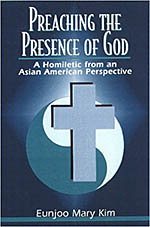Book Review: Preaching the Presence of God: A Homiletic from an Asian American Perspective by Eunjoo Mary Kim
Eunjoo Mary Kim, Preaching the Presence of God: A Homiletic from an Asian American Perspective.
(Valley Forge, PA: Judson Press, 1999). 163 pp. $14.99.

Try Googling “Asian American homiletic” and you will not find many sources. Attend the Academy of Homiletics or the North American Academy of Liturgy, and you will, likewise, not find many Asians /Asian Americans. The pioneering publication of “Preaching the Presence of God” 17 years ago by Korean American homiletics scholar and Iliff School of Theology professor, Eunjoo Mary Kim began a necessary conversation and important consideration of Asian/Asian American preaching, churches, scholarship, and pastoral leadership on the American Christian ecclesial landscape. Churches and the academy are playing catch-up with what had been apparent for many decades in the national and cultural consciousness with Asian/Asian American immigration trending as the fastest growing demographic community in the United States. Thus, the church and the academy owe a debt of gratitude to Professor Kim for this volume, for highlighting to the majority culture the distinctive character of a segment of Asian/Asian American cultures and traditions, and the contribution that Asian/Asian American ethos and pathos bring to the table and to the pulpit.
Kim is clear from the outset that the part of the Asian/Asian American experience she described and which she knows best are those of our sisters and brothers whose first-generation heritage is from Korea, China, and Japan. She herself is a Korean American clergywoman. I myself am a Filipino American clergyman married to a Korean American laywoman. Kim carefully guides us through a brief overview of Confucianism, Buddhism, and shamanism, and their respective strands, and how each of these religious and philosophical perspectives have shaped and influenced Asian/Asian American expressions of Christianity. Any discussion of a truly contextualized Christian spirituality, biblical hermeneutic, and thoroughgoing homiletic for Asian/Asian American Christianity, must necessarily account for these influences. What Kim does so well is to give us a primer of these systems, and how East Asian/Asian American identities are inextricably linked to them and to one another. For instance, the importance of community and the family system resonates well with these indigenous traditions while critiquing the American insistence on independence. Yet, in strands of Buddhism, the full realization of the self would be in sync with that American ethos, where Christianity, particularly of the Reformed tradition to which Kim belongs, regards the self in relation to the body of Christ in relation to the triune God revealed in Jesus Christ through the Holy Spirit; Or, another example, that of the regard of sacred texts in the community. Here, Kim discusses notions of scriptural authority and Word of God and the use of language for listeners/readers to comprehend and apprehend what is taught. In analyzing the traditions and thought patterns, Kim settles upon prescribing what she calls the “spiral” sermonic form that emphasizes metaphor, poetry, and conversation rather than a didactic approach. That the hermeneutic and homiletic which she prescribed emphasize the role of the Spirit and “intuitive imagination” among the listeners, Kim’s spiral-form sermon engages text, context, and subtext in a partnered collaboration where divine-human engagement can occur notwithstanding the limitations of language in expressing the Word.
Having attended many worship services in Korean American churches, and having preached at 1st generation (with English translation), 1.5, and 2nd generation churches in the United States and South Korea, I understood what Kim was describing. Her volume, as stated earlier, did not and could not exhaustively describe the fullness of Asian/Asian American traditions. So, as a Filipino American who grew up in Filipino American churches and who now serves in a largely Anglo congregational and city context, there were limits in which I was able to connect with what Kim described and prescribed. Many of my ministry colleagues, the 1.5 and 2nd generations, serve in multicultural settings or in settings that are different than their own upbringing. Kim’s volume seemed focused on Asian/Asian American pastors and preachers serving in Asian/Asian American churches and ministries. And while there are many racial ethnic ministries where mono-ethnic contexts are a dominant expression, the increasing norm among 1.5, 2nd, and 3rd generation Asian/Asian American leaders is to preach and serve in multicultural settings.
Nevertheless, Kim’s volume is a valuable resource for pastors, preachers, scholars, and seminarians. It continues the dialogue. It underlines the necessity of contextual preaching, homiletic, and hermeneutics. And it highlights the value of the congregation as partners in the spiritual act of worship and in engaging with God, whose Spirit is present with the Church and with the world. Such a theological view is an essential foundation of Asian/Asian American Christianities; thus, this volume’s concentration on that key aspect of Asian/Asian American identity assures this book’s endurance in the Church’s and the academy’s conversation.


